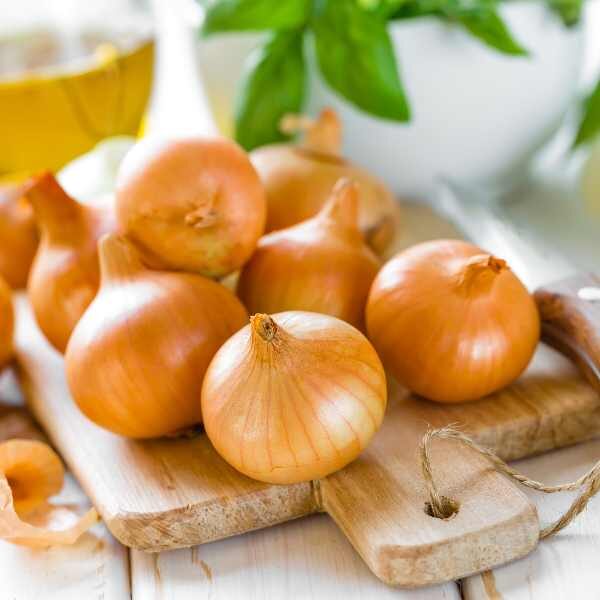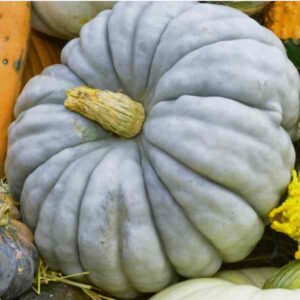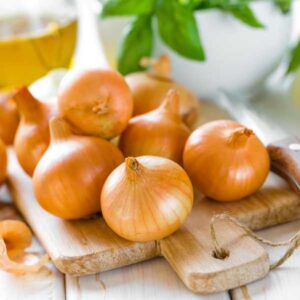Description
Onion Pukekohe Long Keeper are golden brown spheres, with white flesh, and are a staple for every pantry.
A New Zealand originating heirloom suitable for a wide range of climates but not the tropics. Sometimes known as Cream Gold.
The bold flavour and rich white flesh of this mid to late season onion is superior to other onions.
With an excellent shelf life, crops can be stored for up to 10 months ensuring you are always have a supply of these delicious bulbs.
These beauties store for up to 10 months and are slow to bolt to seed. Plant in well drained soil and harvest when the tops dry out.
Hint: Be patient when planting as seeds can take 3 weeks to germinate.
Find your Climate Zone
Method: Sow seedlings
| Soil Temp: 8°C - 30°C
|
Cool Mountain: Feb - Oct
| Position: Full sun
|
Arid: Feb - Aug
| Row Spacing: 10cm apart
|
Temperate: Mar - Aug
| Planting Depth: 5 mm |
Sub Tropical: Not Recommended
| Harvest: 200 days
|
Tropical: Not Recommended
| Plant Height: 25cm
|
Starting Seeds in Trays
Steps:
1.Seed Trays: Use modular trays or small pots with a fine seed raising mix (not garden soil).
2. Sowing: Plant 2–3 seeds per cell, 6mm deep. Lightly cover with mix.
3. Germination: Keep moist and warm (18–25°C). Seeds sprout in 7–14 days. Use a heat mat if needed.
4. Light: Place under grow lights or in a sunny window (12+ hours daily). Rotate trays to prevent leggy seedlings.
5. Thinning: Once seedlings are 5cm tall, snip weaker ones, leaving 1 strong plant per cell.
6. Hardening Off: 1–2 weeks before transplanting, gradually expose seedlings to outdoor conditions (start with 1 hour daily).
7. Transplanting: When seedlings have 3–4 leaves (8–10 weeks old), plant 10–15cm apart in prepared beds.
Pros:
- Extends growing season in cooler zones.
- Protects seedlings from pests/weather early on.
Cons:
- Requires more effort and equipment (lights, trays).
- Risk of transplant shock if not hardened properly.
Direct Sowing
Steps:
1. Soil Prep: Loosen soil to 30cm depth. Mix in compost or aged manure. Remove weeds.
2. Sowing:
- Create shallow furrows 1cm deep.
- Sow seeds 2–3cm apart, then cover lightly with soil.
- Water gently to avoid dislodging seeds.
3. Spacing: Thin seedlings to 10–15cm apart when 5–8cm tall (use thinnings as green onions).
4. Mulching: Apply straw or sugar cane mulch to retain moisture and suppress weeds.
Pros:
- Less labour intensive.
- Avoids transplant shock.
Cons:
- Slower growth in cool soil.
- Vulnerable to pests (e.g., slugs, birds) and weather extremes.
Key Tips for Both Methods
Watering: Keep soil consistently moist until seedlings establish. Reduce watering as bulbs form to prevent rot.
Fertilising: Apply a nitrogen rich fertilizer (e.g., fish emulsion) every 2–3 weeks until bulbs swell, then switch to low nitrogen feed.
Pest Control:
- Cover seedlings with insect mesh to deter onion flies.
- Sprinkle diatomaceous earth around plants for grub prevention.
Thinning: Crucial for bulb development—crowded onions stay small.
Common Mistakes
1. Overcrowding: Leads to competition for nutrients and stunted bulbs.
2. Poor Drainage: Onions rot in waterlogged soil—ensure raised beds in wet climates.
3. Late Transplanting: Seedlings older than 10 weeks struggle to adapt.
Hacks
Tray Starter Hack:
- Trim seedling tops to 10cm tall if they become leggy. This strengthens stems.
Direct Sow Hack:
- Mix radish seeds with onion seeds—radishes mark rows and break soil crust for onion sprouts.
Harvest
When:
- Tops yellow and fall over for full size onion. Lift bulbs gently.
- Before bulb starts to swell for spring onions
Curing:
- Dry in a shaded, ventilated area for 2–3 weeks. Store in mesh bags in cool (0–4°C), dark conditions.
Companion Planting Guide
Plant With:
- Carrots: Deter each other’s pests (onion/carrot flies).
- Brassicas (cabbage, kale): Repel cabbage worms.
- Tomatoes/Capsicums: Onions deter aphids and beetles.
- Chamomile: Enhances onion flavour.
- Marigolds: Suppress nematodes and beetles.
Avoid:
- Legumes (peas, beans): Compete for nutrients.
- Asparagus: Inhibits growth.
- Other alliums (garlic, leeks): Attract shared pests like onion maggots.
Seed Saving Guide
1. Select Bulbs: Save seeds from large, disease free onions.
2. Overwinter: Replant best bulbs in spring; onions flower in their second year.
3. Isolate Varieties: Prevent crosspollination by spacing varieties 1 – 2km apart or bagging flower heads.
4. Harvest Seeds: Let flower heads dry on plants. Shake seeds into a container and remove chaff.
5. Storage: Keep in airtight containers in a cool, dry place. Seeds remain viable 1–2 years.
Troubleshooting
Pests: Use neem oil for thrips or onion maggots. Interplant marigolds for nematode control.
Diseases: Rotate crops yearly to prevent fungal issues (e.g., downy mildew). Avoid overwatering.
Weeds: Mulch with straw or plant quick growing greens (lettuce, rocket) as living mulch.




 Pumpkin Jarrahdale
Pumpkin Jarrahdale 
3 reviews for Onion Pukekohe Long Keeper